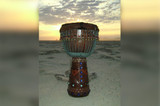Drum Roll Demystified
Many consider the drum roll to be one of the most fundamental rudiments that a drummer needs to know. The basic idea behind a drum roll is that, with each stroke, the drummer will allow the drum stick to bounce making an extra beat creating the impression that there is one continuous sound emanating from the drum. But how does one produce a roll on a hand drum without sticks or mallets?
In reality, a seasoned drummer will tell you that if you want a controlled roll with a clear, even sound, you do not want to simply bounce your sticks. A skilled percussionist will explain that proper technique involves a double stroke sometimes referred to as a ‘diddle’. Two separate and controlled strokes that are a beat on the drum on each hand in rapid succession will create the desired effect. The rebound qualities of the drum head will aid the performer in quickly playing the second note as will assistance from the fingertips: the primary stroke will be played with wrists whereas the secondary stroke will be played with the finger tips pushing down on the drum stick.
This primary and secondary beat system can be replicated on a hand drum without a stick using a couple of different techniques.
The first method is called the heal-toe roll. In this process, each hand alternates between a tap from the meaty, base of the hand (the ‘heal’) and the fingertips (the ‘toes’). Switching from one hand to the other (Right-Heal, Right-Toe, Left-Heal, Left-Toe, repeat) will produce the sound of a roll.
The second method involves using your fingertips: simply alternate between fore finger and middle finger (Right-Fore, Right-Middle, Left-Fore, Left-Middle, repeat). This method is helpful is you are performing a style of drumming that requires a lighter sound.
Both of these techniques require practice to perfect; however, once they are mastered, they can be used as either a straightforward roll or incorporated into existing rhythms to create more complex beats and extra flourishes that will assist you in developing your own unique style of play.
Recent Posts
-
What is the Best Size Djembe for Beginners?
If you're new to the world of percussion and interested in learning the djembe, you're in for a t …16th Jul 2024 -
The Benefits of Becoming a Drumming Teacher: Transforming Passion into Profession
Why become a drumming teacher? Becoming a drumming teacher is an excellent way to share your pas …22nd May 2024 -
What Makes the Djembe Drum a Spiritual Instrument in African Music?
Origin and history of the Djembe drum The Djembe drum originates from West Africa and holds sign …16th May 2024



